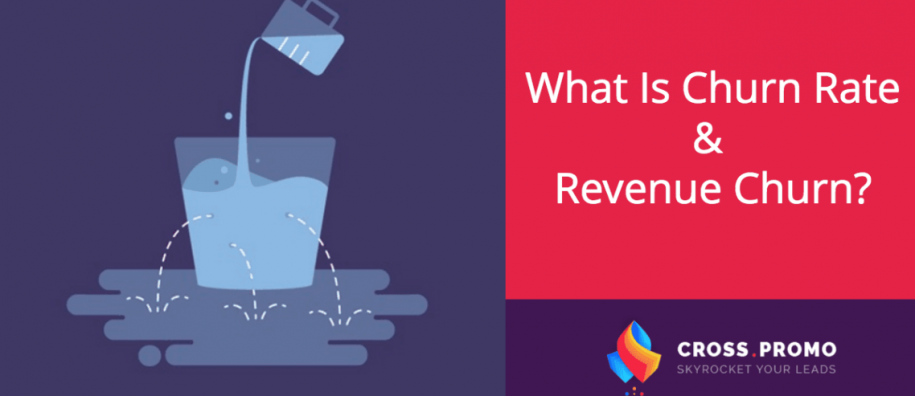Every SaaS and E-commerce business has several indicators that can quickly tell how well the business is performing. Some of these indicators that you might have come across are called Churn Rate and Revenue Churn.
Below I’ll explain what Churn Rate and Revenue Churn for SaaS and E-commerce is, how it can impact businesses and how to calculate them. Let’s dive into more details.
What Is Churn Rate?
Churn rate indicates the percentage of customers or subscribers a business is losing during a given time interval. These lost users are called “churned”. Churn is considered by many, the enemy of subscription based companies.
How To Calculate Churn Rate
Calculating the churn rate of a business is very straightforward. You take the number of customers that you lost on any time interval you want, and then divide it by the number of clients you had at the beginning. The percentage resulted is called churn rate.
If a Software As A Service business started with 800 active subscribers but lost 100 in any given month, the churn rate is 8%. For a business to be successful, it’s growth rate must exceed its churn rate or otherwise, it would be running on a negative balance.
Let’s discuss another scenario to help you understand better. If a business started the first quarter of the year with 5250 paying subscribers and lost an average of 120 customers per month, the churn rate will be calculated as follow:
120 lost subscribers divided by 5250 paying subscribers = 2.2% churn rate in the first quarter
You can calculate the churn rate monthly, quarterly or yearly.
What is considered an acceptable churn rate?
Churn is never acceptable. It can be tolerable, or as some CEOs prefer to say, “it’s fine”.
Sure, you can live with it, and you can still have a successful business, but the fact that you are losing users and revenue is never a good sign. Having a churn rate or revenue churn means that if you didn’t earn any new subscribers, you would see an X% loss each month.
For example, if you start with 1000 customers in January, with a 5% monthly churn rate, without any new customers, you would end up having just 540 customers at the end of December. Needless to say, that’s bad. It’s impossible to have a zero churn rate, but as long as that’s kept at a lowest possible and the business gets significantly more new subscribers than the ones it’s losing, you are indeed fine.
Most businesses can afford to lose some subscribers each month because they earn more in return and as long as the balance between the lost and gained customers is positive, the business will keep going.
How can SaaS and Ecommerce businesses reduce churn rate?
By convincing users not to close their subscriptions and keep paying you money. Sounds simple?! It’s not, of course. Not all SaaS are created equal and sometimes churn rate is out of your control.
However, there are various things to be taken into consideration when trying to reduce the churn rate. The best way to get started is to ask your customers why they have decided to close their subscription.
By addressing some of the most frequent reasons why people close their subscriptions, you can take another step that can reduce your churn rate. Here’s a list of reasons why SaaS subscriptions are being closed:
- Bad customer support
- The platform is full of bugs
- Recurring payment failed, and the user was not aware
- Competitors are offering more for less money
- No need to use the business services anymore
What is Revenue Churn?
Revenue churn is a metric that indicates how much recurring revenue a SaaS or E-commerce business has lost in any given month or quarter. Unlike Churn Rate, which is almost always being represented by a percentage, revenue churn is sometimes expressed as a whole number.
Revenue churn can be categorized as follow:
- Revenue churn from lost or canceled subscriptions.
- Revenue churn from subscription downgrades
- Revenue churn for all subscriptions
Considering most subscription based businesses have different prices for their plans, revenue churn is often much more relevant than churn rate. For example, if a company has lost a small number of subscribers, but some of those were using the most expensive plans, the churn rate might be lower, but the recurring revenue will be much more impacted. Therefore, revenue churn has a much more significant impact on a business budget.
How To Calculate Revenue Churn?
Revenue churn is calculated by dividing the revenue the business had at the beginning of the quarter or month with the number of revenue lost in the last month.
Calculate quarterly revenue churn:
Revenue started at the beginning of the quarter, divided by the lost revenue at the end of the quarter.
Example: Started the quarter with $25.000 per month, and lost a total of $3000. The revenue churn is 12%.
Calculate monthly revenue churn:
Revenue started at the beginning of the month, divided by the lost revenue in that month.
Example: Started with $30.000 per month, and lost $1000 recurring revenue. The churn of income is 3.3%.
Below you can find one last scenario for revenue churn calculation.
A business that started the first quarter with a recurring revenue of $29000 per month, and lost $3000 in the last month, will have a revenue churn rate of 10%. The same business might have a 8% churn rate for it’s churned users, but there are cases when the business can have a recurring revenue increase, even with a high churn rate.
That’s it. Now you should know what is churn rate and revenue churn and also how to calculate both metrics. Remember that churn is always your business enemy and you should do your best to replace these metrics with positive growth.

